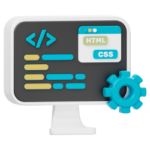On Page SEO
On Page SEO Services
Keyword & Content Strategy
- Keyword Research & Analysis
- Content Gap & Topic Cluster Planning
- Content Creation & Optimization
- Content Freshness & Updates
HTML Elements Optimization
- Title Tag Optimization
- Meta Description Optimization
- Header Tag Structuring (H1–H6)
- Schema & Structured Data Markup
URL & Site Structure
- SEO‑Friendly URL & Permalink Design
- Internal Linking Architecture
- Breadcrumb Navigation
Media Optimization
- Image & Multimedia SEO
- Video & Embed Optimization
- Alt Text
Performance & UX
- Mobile UX & Responsiveness
- Core Web Vitals (LCP, CLS, FID) Remediation
- Accessibility & ARIA Attributes
Technical‑Adjacent On‑Page
- Canonical Tags & Duplicate Content Resolution
- Robots Meta Tags & Index Control
Analytics & Testing
- Google Analytics & Search Console Setup
- Keyword Ranking Tracking
- A/B Testing & CRO Recommendations
What It Is: Definition & Business Impact
On‑Page SEO (also called on‑site SEO) is the practice of optimizing individual web pages—their content and HTML source—to rank higher and earn more relevant traffic in search engines. It encompasses everything from refining title tags and meta descriptions to structuring headers, optimizing images, and implementing schema markup. By ensuring each page clearly signals its topic and intent to both users and crawlers, On‑Page SEO lays the foundation for visibility in search results and directly influences user engagement metrics like click‑through rate (CTR) and time on page Business Impact
- Higher Organic Traffic: Better‑optimized pages climb SERPs, capturing more clicks from users actively searching for your products or services.
- Improved User Engagement: Clear structure and relevant content reduce bounce rates and increase dwell time, sending positive quality signals to Google.
- Increased Conversions: Pages that match search intent more closely drive qualified visitors, boosting form fills, sign‑ups, and sales.
- Long‑Term ROI: Unlike paid ads, on‑page improvements compound over time—once a page ranks well, it can sustain traffic with minimal ongoing cost
Our Process: Tools & Step‑by‑Step Approach
- Discovery & Benchmarking
- Tools: Google Search Console, Semrush On‑Page SEO Checker, Screaming Frog
- Actions: Crawl your site to inventory pages, capture current rankings, CTR, and engagement metrics.
- Tools: Google Search Console, Semrush On‑Page SEO Checker, Screaming Frog
- Keyword & Intent Mapping
- Tools: Ahrefs, Moz, Google Keyword Planner
- Actions: Identify primary, secondary, and LSI keywords for each page; align with user search intent.
- Tools: Ahrefs, Moz, Google Keyword Planner
- HTML Element Optimization
- Tools: Yoast SEO (WordPress), Rank Math, manual code review
- Actions: Craft unique title tags (50–60 chars) and meta descriptions (150–160 chars); structure H1–H6 tags to reflect content hierarchy.
- Tools: Yoast SEO (WordPress), Rank Math, manual code review
- Content Enhancement
- Tools: Surfer SEO, Clearscope, Grammarly
- Actions: Optimize body copy for depth and readability; incorporate keywords naturally; add clear CTAs.
- Tools: Surfer SEO, Clearscope, Grammarly
- Media & Schema Implementation
- Tools: Google’s Rich Results Test, Schema App
- Actions: Optimize images (file names, alt text, srcset, lazy‑loading); add JSON‑LD for FAQ, How‑To, Product schemas.
- Tools: Google’s Rich Results Test, Schema App
- Internal Linking & URL Structure
- Tools: Sitebulb, Link Whisper
- Actions: Build logical internal links to distribute authority; ensure clean, keyword‑rich URLs.
- Tools: Sitebulb, Link Whisper
- Testing & Validation
- Tools: PageSpeed Insights, Lighthouse, A/B testing platforms (Optimizely, VWO)
- Actions: Validate on‑page changes; run A/B tests for titles and CTAs; monitor Core Web Vitals.
- Tools: PageSpeed Insights, Lighthouse, A/B testing platforms (Optimizely, VWO)
- Reporting & Continuous Improvement
- Tools: Google Data Studio, Tableau, weekly automated dashboards
- Actions: Track KPIs; review performance monthly; refresh content and metadata as needed.
- Tools: Google Data Studio, Tableau, weekly automated dashboards
Expected Outcomes: KPIs & Benefits
| KPI | Benefit |
| Organic Click‑Through Rate | Higher CTR from SERPs indicates more compelling titles/descriptions and drives traffic growth. |
| Average Time on Page | Longer sessions reflect engaging, relevant content—boosts quality signals to search engines. |
| Bounce Rate | Lower bounce rates demonstrate better user satisfaction and intent matching. |
| Rankings for Target Keywords | Movement into top 3 positions exponentially increases visibility and traffic share. |
| Page Speed & Core Web Vitals | Faster, stable pages improve UX, reduce abandonment, and can lead to ranking gains. |
| Conversion Rate | More qualified traffic translates into higher form‑fill and sales conversion percentages. |
Case Studies & Testimonials
Case Study: E‑commerce Core Web Vitals Overhaul
- Challenge: Mobile LCP at 5.2 s; CLS failure rate 60%
- Solution: Implemented lazy‑loading, code minification, and optimized critical CSS
- Results: LCP reduced to 1.8 s; CLS down to 5%; organic mobile sessions ↑ 38% in 3 months
Client Testimonial
“Need Order’s on‑page optimizations not only got us back into the top 3 for our key terms but also doubled our mobile conversion rate. Their attention to detail is unmatched.”
— Head of Digital, Fashion Retailer




